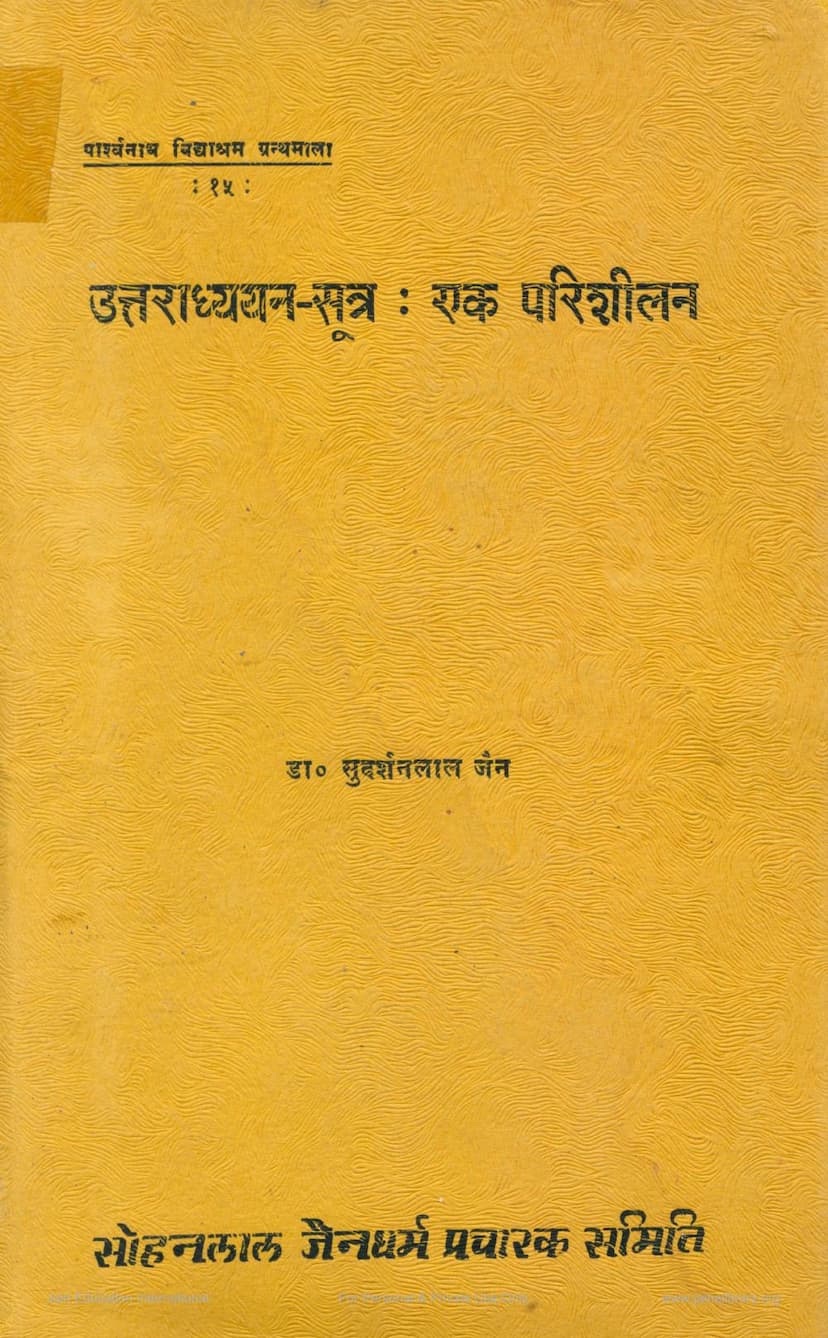Uttaradhyayan Sutra Ek Parishilan
Added to library: September 2, 2025

Summary
Here's a comprehensive summary of the Jain text "Uttaradhyayan Sutra: Ek Parishilan" by Sudarshanlal Jain, based on the provided pages:
Book Title: Uttaradhyayan Sutra: Ek Parishilan (A Study of the Uttaradhyayan Sutra)
Author: Dr. Sudarshanlal Jain (M.A., Ph.D., Acharya in Jain Philosophy, Literature, and Prakrit)
Publisher: Sohanlal Jaindharm Pracharak Samiti, Amritsar
Catalog Link: https://jainqq.org/explore/004252/1
Publication Year: 1970
Nature of the Work: This book is a doctoral dissertation approved by Banaras Hindu University, offering a comprehensive critical study of the Uttaradhyayan Sutra, a significant text in Jain Agama literature, which is also respectfully mentioned in Digambara literature. The study aims to present the core subject matter of the original text in a simple and understandable language.
Key Aspects and Content Covered:
-
Introduction (Prastavika):
- Significance of Uttaradhyayan Sutra: The text highlights the special place of the Uttaradhyayan Sutra in Jain Agama literature, noting its mention in Digambara literature as well.
- Time Period and Authorship: It delves into the chronology and authorship considerations of the Uttaradhyayan Sutra.
- Etymology of the Name: The reasoning behind the name "Uttaradhyayan" is discussed.
- Language, Style, and Importance: An analysis of the Prakrit language, the literary style, and the overall significance of the text is presented.
- Commentarial Literature and Editions: A list of various commentaries and editions of the Uttaradhyayan Sutra is provided.
-
Core Philosophical and Ethical Concepts: The summary indicates the Uttaradhyayan Sutra primarily discusses the conduct and principles of monks, along with fundamental Jain philosophical tenets. The study by Dr. Jain aims to elucidate these concepts in a clear manner.
-
Structure of the Dissertation:
- Introduction: Covers the place of Uttaradhyayan in Jain Agama literature, introduction to its subject matter, period of composition, reasons for its name, language, style, importance, and details about its commentary literature and various editions.
- Eight Chapters: The main body of the dissertation is divided into eight chapters, each focusing on a specific aspect of the Uttaradhyayan Sutra's teachings:
- Chapter 1: Dravya-Vichar (Discourse on Substances): Deals with the geographical structure of the universe, the nature of creation, and the essence of substances. It explains the Jain concept of the universe being eternal and self-existent, driven by inherent principles. It also discusses the impermanence and illusory nature of the worldly existence from a spiritual perspective. It introduces the fundamental Jain concept of Jiva (conscious) and Ajiva (unconscious) as the two fundamental elements that constitute beings, similar to matter and energy in modern science. The study emphasizes that the differences observed in beings arise from the interaction of the Jiva with Ajiva (pudgala).
- Chapter 2: Sansar (The Cycle of Existence): Explores the suffering inherent in the cycle of existence and its causes, particularly focusing on the Karma theory. It argues against fatalism, explaining karma as a principle of cause and effect.
- Chapter 3: Ratnatraya (The Three Jewels): Details the path to liberation, focusing on Samyakdarshan (Right Faith), Samyakgnan (Right Knowledge), and Samyakcharitra (Right Conduct) as the core components of liberation.
- Chapter 4: Samanya Sadhvachara (General Monastic Conduct): Discusses the general ethical guidelines for monks.
- Chapter 5: Vishesh Sadhvachara (Special Monastic Conduct): Covers the specialized practices of monks, particularly Tapascharya (Austerities).
- Chapter 6: Mukti (Liberation): Discusses the state of liberation, its characteristics, and the qualities of liberated souls.
- Chapter 7: Samaj aur Sanskriti (Society and Culture): Analyzes the social and cultural aspects reflected in the text, including the Varna-Ashrama system, family life, customs, rituals, and beliefs prevalent during that period.
- Chapter 8: Upasanhara (Conclusion): Provides a concluding overview and summary of the entire dissertation.
- Four Appendices:
- Appendix 1: Katha-Samvad (Narratives and Dialogues): Presents key dialogues and stories from the Uttaradhyayan Sutra.
- Appendix 2: Vishisht Vyaktion ka Parichay (Introduction to Notable Personalities): Provides biographical sketches of important individuals mentioned in the text.
- Appendix 3: Sadhavachara Sambandhi Kuch Anya Gyatavya Tathya (Other Notable Facts Regarding Monastic Conduct): Offers supplementary information on monastic practices.
- Appendix 4: Desh tatha Nagar (Countries and Cities): Identifies and describes geographical locations mentioned in the text.
- Bibliographical Information: Includes a list of reference books, an index, and tables/charts.
- Critical Analysis: Each chapter concludes with a critical review or analysis (Anushilan).
-
Funding and Dedication:
- The publication cost was borne by Shri Munilal and Bhaai Loknath in memory of their father, the late Lala Laddhamal Ji Jain (of Lahore).
- The book is dedicated to the revered Guru, Dr. Siddheshwar Bhattacharya.
-
Author's Background: Dr. Sudarshanlal Jain received a research scholarship from the family of the late Seth Nathalal M. Parakh.
-
Publisher's Context: The Sohanlal Jaindharm Pracharak Samiti considers this publication its fifth research volume, with Dr. Sudarshanlal Jain being their sixth successful research scholar. The committee is actively supporting other scholars pursuing doctorates in Jain subjects.
-
Significance of the Work: The publisher emphasizes that this dissertation offers a comprehensive critical study of the Uttaradhyayan Sutra, recognizing it as an excellent religious poetic work within Prakrit literature. The book is expected to be highly valuable for understanding the essence of the Uttaradhyayan Sutra easily.
Overall Theme and Approach: The book provides a detailed academic and critical examination of the Uttaradhyayan Sutra, covering its philosophical underpinnings, ethical guidelines for ascetics, and the social context reflected within the text. It is presented as a scholarly work that makes the profound teachings of this Jain scripture accessible to a wider audience. The research is noted for its thoroughness, including an analysis of the universe, the concept of suffering in Sansara, the path of liberation through Ratnatraya, and the detailed code of conduct for monks. The study also aims to highlight the literary and cultural aspects embedded within the ancient Jain text.